Abstract
Twenty children who were well six to 12 years after undergoing Mustard's operation for transposition of the great arteries were studied. Each child performed a graded maximal treadmill test with measurements of gas exchange and oxygen saturation, and had electrocardiography carried out. Nineteen were also catheterised, and oxygen consumption was measured so that pulmonary and systemic flow could be calculated. Compared with 20 age and size matched controls, seven of the patients had normal exercise tolerance (as judged by a maximal oxygen consumption of greater than 40 ml/kg/min), 10 showed a moderate reduction (30-39 ml/kg/min), and three were more seriously limited. None of the patients with normal exercise tolerance had obstruction of venous return but six of those with mild impairment of exercise ability had partial or complete obstruction of one or both of the vena cavas. More severe limitation was associated with pulmonary vascular disease and fixed ventricular outflow tract obstruction. Formal exercise testing of apparently well children who have undergone Mustard's operation identifies those with haemodynamic abnormalities that may require intervention.
Full text
PDF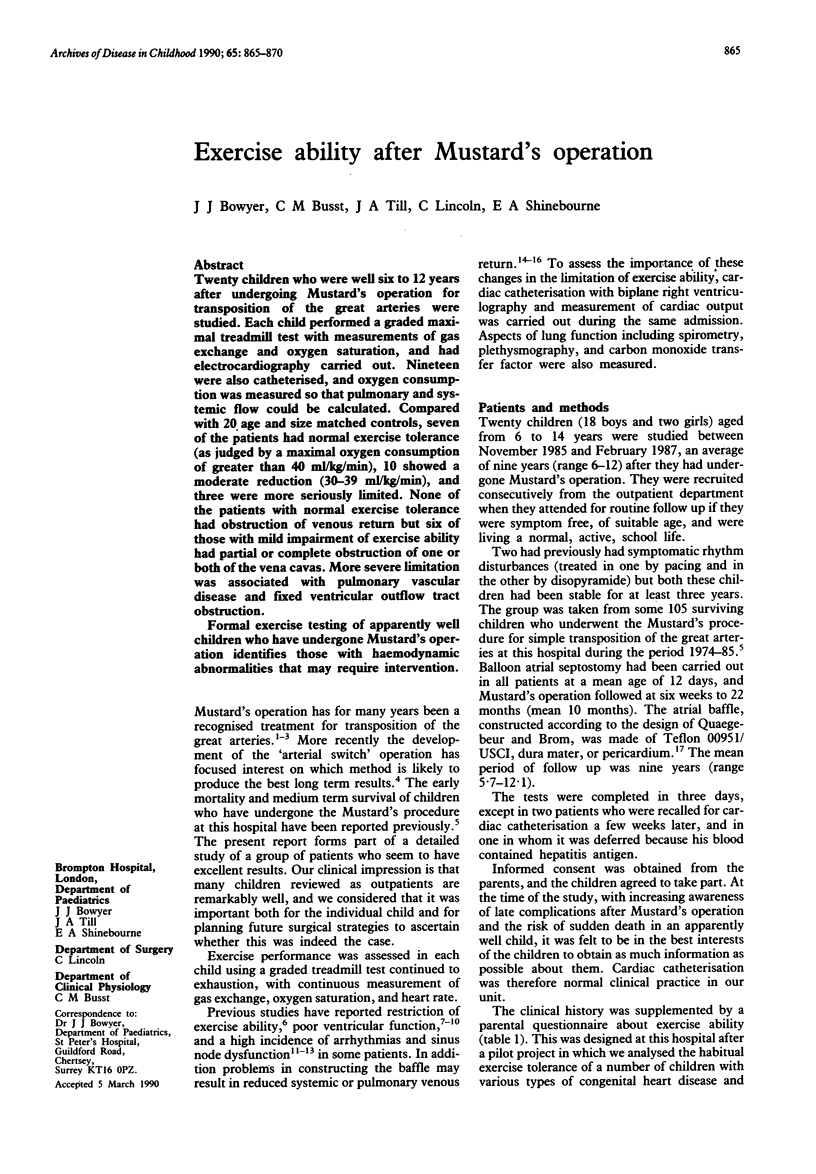
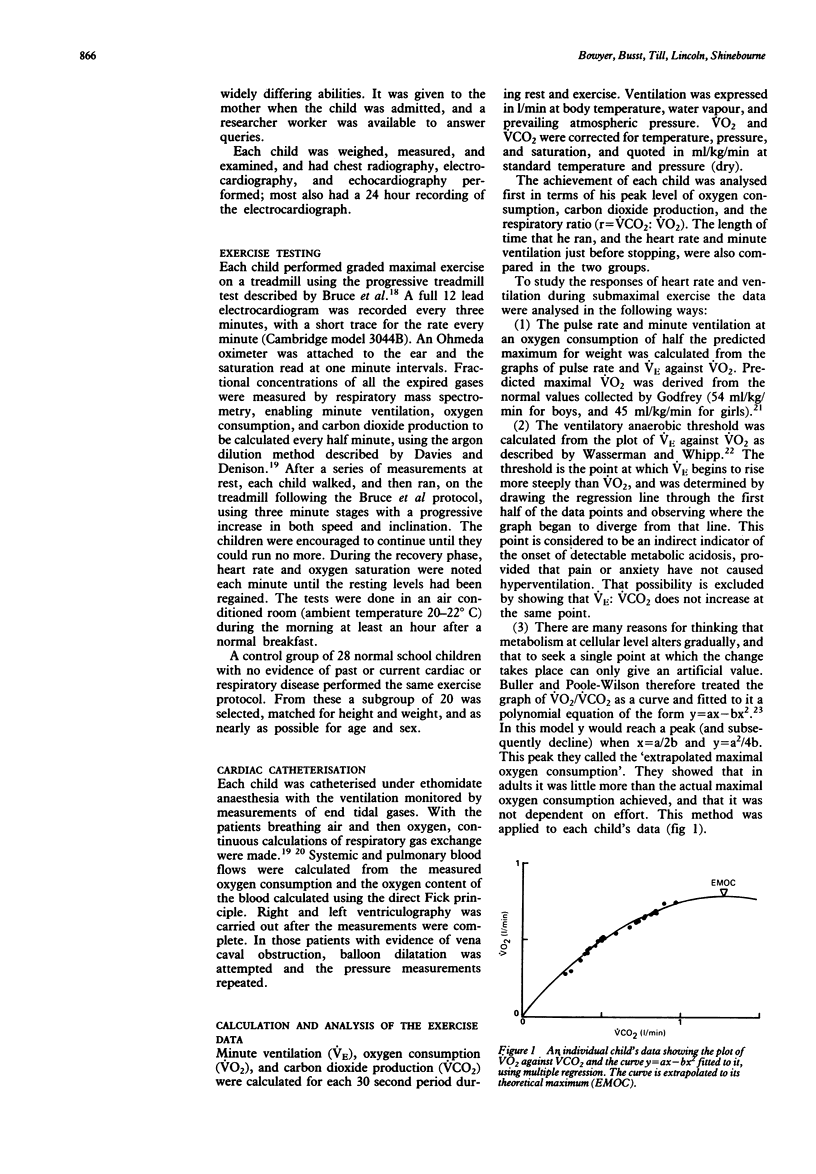
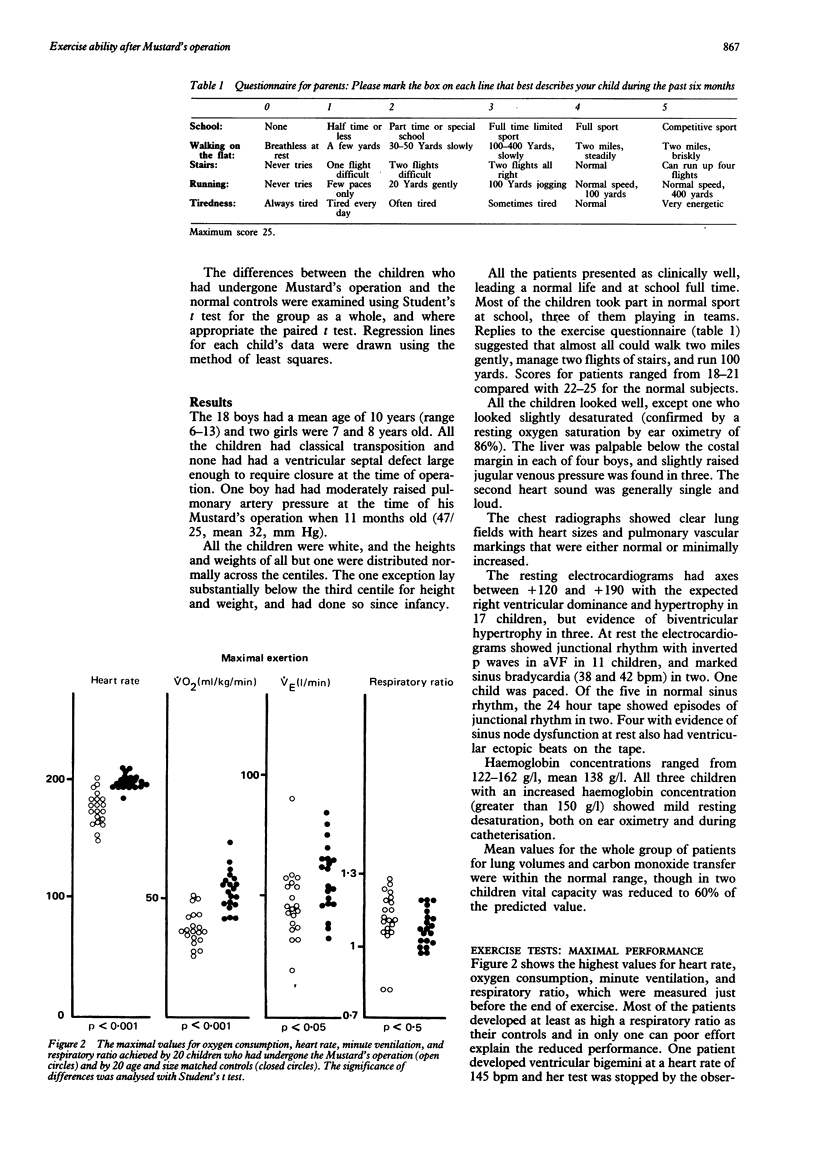
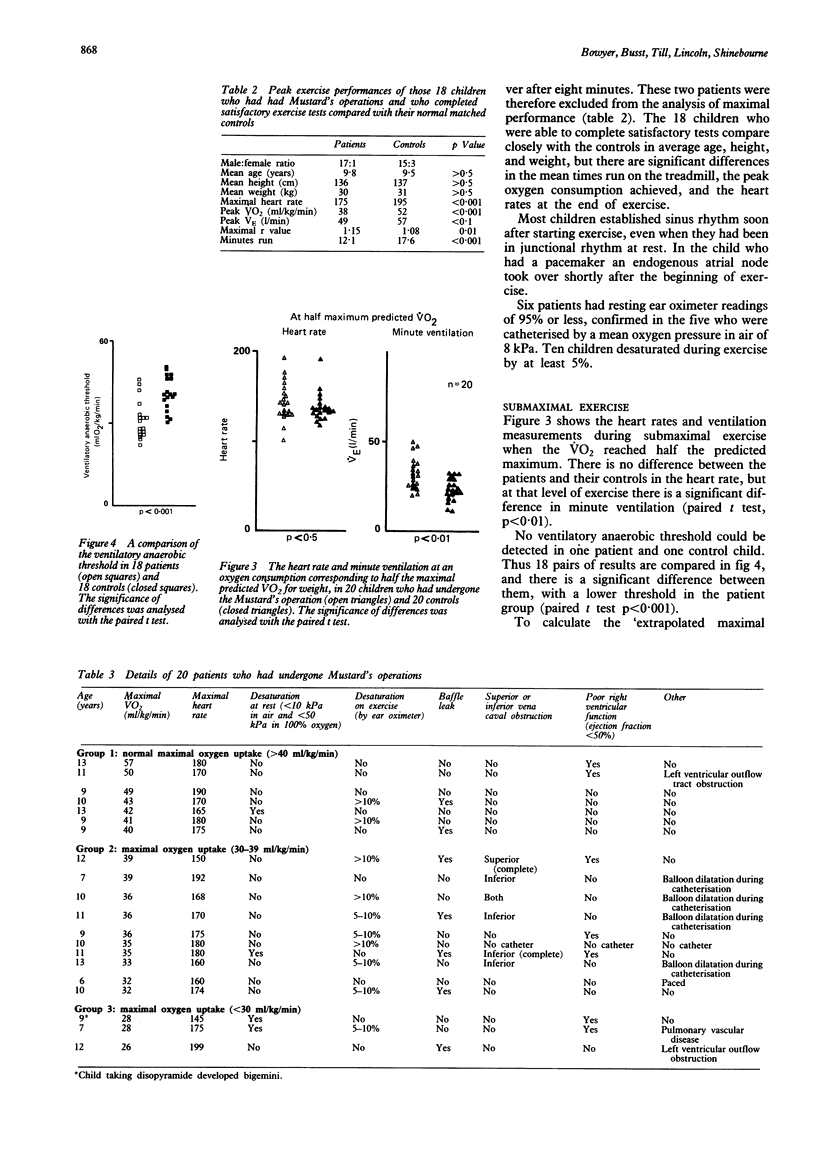
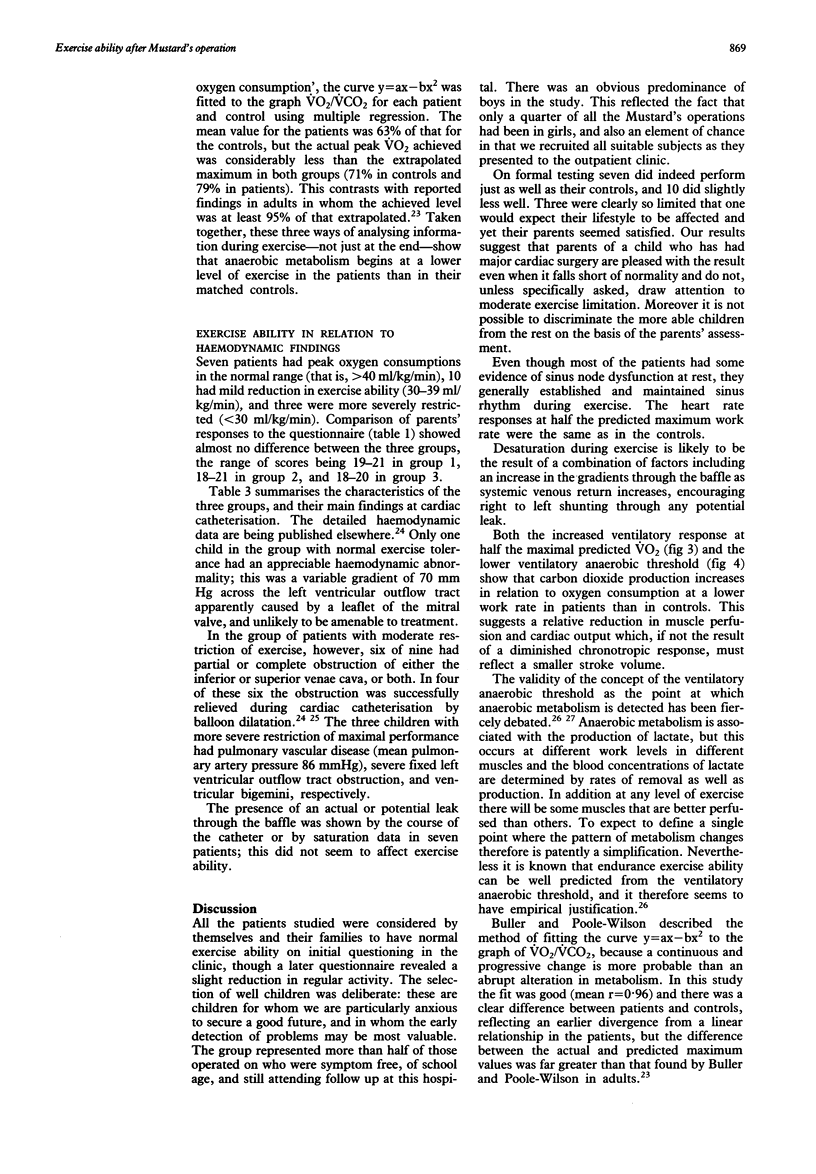
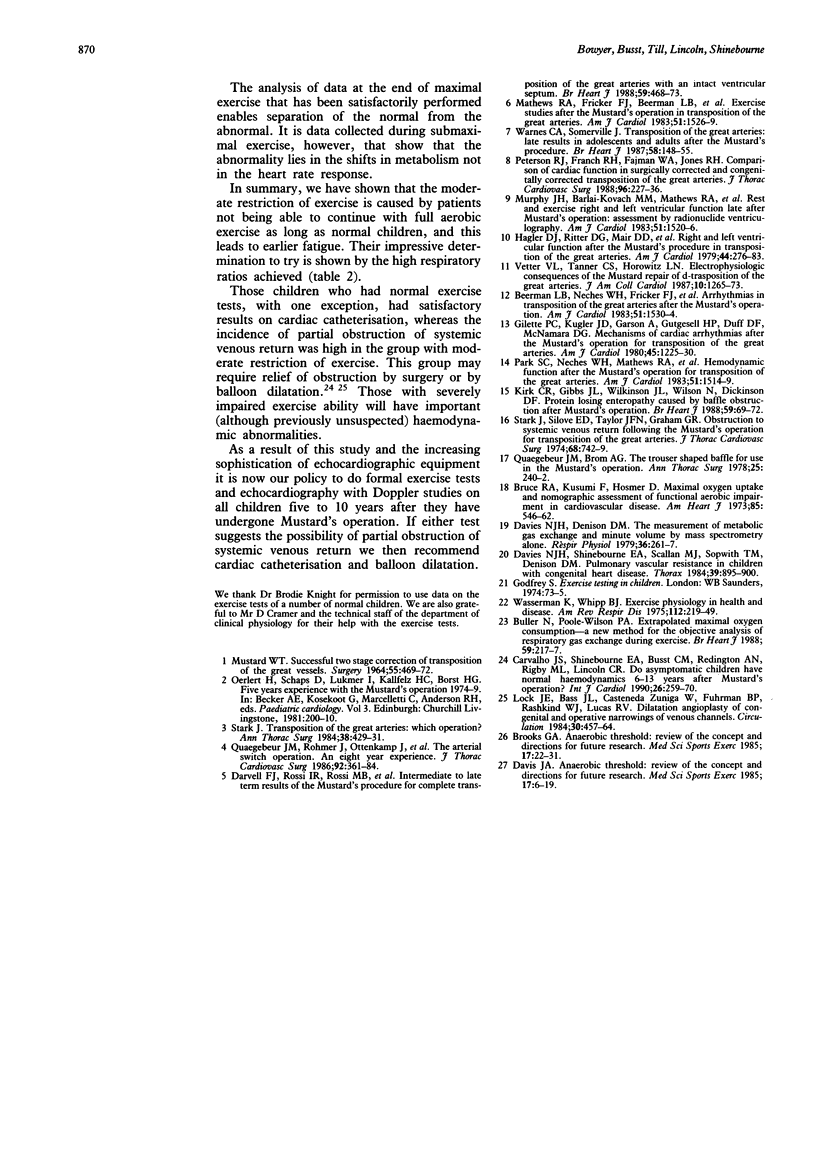
Selected References
These references are in PubMed. This may not be the complete list of references from this article.
- Beerman L. B., Neches W. H., Fricker F. J., Mathews R. A., Fischer D. R., Park S. C., Lenox C. C., Zuberbuhler J. R. Arrhythmias in transposition of the great arteries after the Mustard operation. Am J Cardiol. 1983 May 15;51(9):1530–1534. doi: 10.1016/0002-9149(83)90671-9. [DOI] [PubMed] [Google Scholar]
- Brooks G. A. Anaerobic threshold: review of the concept and directions for future research. Med Sci Sports Exerc. 1985 Feb;17(1):22–34. [PubMed] [Google Scholar]
- Bruce R. A., Kusumi F., Hosmer D. Maximal oxygen intake and nomographic assessment of functional aerobic impairment in cardiovascular disease. Am Heart J. 1973 Apr;85(4):546–562. doi: 10.1016/0002-8703(73)90502-4. [DOI] [PubMed] [Google Scholar]
- Buller N. P., Poole-Wilson P. A. Extrapolated maximal oxygen consumption: a new method for the objective analysis of respiratory gas exchange during exercise. Br Heart J. 1988 Feb;59(2):212–217. doi: 10.1136/hrt.59.2.212. [DOI] [PMC free article] [PubMed] [Google Scholar]
- Carvalho J. S., Busst C. M., Redington A. N., Lincoln C. R., Rigby M. L., Shinebourne E. A. Do asymptomatic school children have normal haemodynamics 6-13 years after Mustard's operation? Int J Cardiol. 1990 Mar;26(3):259–270. doi: 10.1016/0167-5273(90)90081-f. [DOI] [PubMed] [Google Scholar]
- Darvell F. J., Rossi I. R., Rossi M. B., Fayers P., Anderson R. H., Rigby M. L., Shinebourne E. A., Lincoln C. Intermediate to late term results of Mustard's procedure for complete transposition of the great arteries with an intact ventricular septum. Br Heart J. 1988 Apr;59(4):468–473. doi: 10.1136/hrt.59.4.468. [DOI] [PMC free article] [PubMed] [Google Scholar]
- Davies N. J., Denison D. M. The measurement of metabolic gas exchange and minute volume by mass spectrometry alone. Respir Physiol. 1979 Feb;36(2):261–267. doi: 10.1016/0034-5687(79)90029-x. [DOI] [PubMed] [Google Scholar]
- Davies N. J., Shinebourne E. A., Scallan M. J., Sopwith T. A., Denison D. M. Pulmonary vascular resistance in children with congenital heart disease. Thorax. 1984 Dec;39(12):895–900. doi: 10.1136/thx.39.12.895. [DOI] [PMC free article] [PubMed] [Google Scholar]
- Davis J. A. Anaerobic threshold: review of the concept and directions for future research. Med Sci Sports Exerc. 1985 Feb;17(1):6–21. [PubMed] [Google Scholar]
- Gillette P. C., Kugler J. D., Garson A., Jr, Gutgesell H. P., Duff D. F., McNamara D. G. Mechanisms of cardiac arrhythmias after the Mustard operation for transposition of the great arteries. Am J Cardiol. 1980 Jun;45(6):1225–1230. doi: 10.1016/0002-9149(80)90482-8. [DOI] [PubMed] [Google Scholar]
- Hagler D. J., Ritter D. G., Mair D. D., Tajik A. J., Seward J. B., Fulton R. E., Ritman E. L. Right and left ventricular function after the Mustard procedure in transposition of the great arteries. Am J Cardiol. 1979 Aug;44(2):276–283. doi: 10.1016/0002-9149(79)90317-5. [DOI] [PubMed] [Google Scholar]
- Kirk C. R., Gibbs J. L., Wilkinson J. L., Wilson N., Dickinson D. F., Qureshi S. A. Protein-losing enteropathy caused by baffle obstruction after Mustard's operation. Br Heart J. 1988 Jan;59(1):69–72. doi: 10.1136/hrt.59.1.69. [DOI] [PMC free article] [PubMed] [Google Scholar]
- Lock J. E., Bass J. L., Castaneda-Zuniga W., Fuhrman B. P., Rashkind W. J., Lucas R. V., Jr Dilation angioplasty of congenital or operative narrowings of venous channels. Circulation. 1984 Sep;70(3):457–464. doi: 10.1161/01.cir.70.3.457. [DOI] [PubMed] [Google Scholar]
- MUSTARD W. T. SUCCESSFUL TWO-STAGE CORRECTION OF TRANSPOSITION OF THE GREAT VESSELS. Surgery. 1964 Mar;55:469–472. [PubMed] [Google Scholar]
- Mathews R. A., Fricker F. J., Beerman L. B., Stephenson R. J., Fischer D. R., Neches W. H., Park S. C., Lenox C. C., Zuberbuhler J. R. Exercise studies after the Mustard operation in transposition of the great arteries. Am J Cardiol. 1983 May 15;51(9):1526–1529. doi: 10.1016/0002-9149(83)90670-7. [DOI] [PubMed] [Google Scholar]
- Murphy J. H., Barlai-Kovach M. M., Mathews R. A., Beerman L. B., Park S. C., Neches W. H., Zuberbuhler J. R. Rest and exercise right and left ventricular function late after the Mustard operation: assessment by radionuclide ventriculography. Am J Cardiol. 1983 May 15;51(9):1520–1526. doi: 10.1016/0002-9149(83)90669-0. [DOI] [PubMed] [Google Scholar]
- Park S. C., Neches W. H., Mathews R. A., Fricker F. J., Beerman L. B., Fischer D. R., Lenox C. C., Zuberbuhler J. R. Hemodynamic function after the Mustard operation for transposition of the great arteries. Am J Cardiol. 1983 May 15;51(9):1514–1519. doi: 10.1016/0002-9149(83)90668-9. [DOI] [PubMed] [Google Scholar]
- Peterson R. J., Franch R. H., Fajman W. A., Jones R. H. Comparison of cardiac function in surgically corrected and congenitally corrected transposition of the great arteries. J Thorac Cardiovasc Surg. 1988 Aug;96(2):227–236. [PubMed] [Google Scholar]
- Quaegebeur J. M., Brom A. G. The trousers-shaped baffle for use in the Mustard operation. Ann Thorac Surg. 1978 Mar;25(3):240–242. doi: 10.1016/s0003-4975(10)63531-x. [DOI] [PubMed] [Google Scholar]
- Quaegebeur J. M., Rohmer J., Ottenkamp J., Buis T., Kirklin J. W., Blackstone E. H., Brom A. G. The arterial switch operation. An eight-year experience. J Thorac Cardiovasc Surg. 1986 Sep;92(3 Pt 1):361–384. [PubMed] [Google Scholar]
- Stark J., Silove E. D., Taylor J. F., Graham G. R. Obstruction to systemic venous return following the Mustard operation for transposition of the great arteries. J Thorac Cardiovasc Surg. 1974 Nov;68(5):742–749. [PubMed] [Google Scholar]
- Stark J. Transposition of the great arteries: which operation? Ann Thorac Surg. 1984 Nov;38(5):429–431. doi: 10.1016/s0003-4975(10)64177-x. [DOI] [PubMed] [Google Scholar]
- Vetter V. L., Tanner C. S., Horowitz L. N. Electrophysiologic consequences of the Mustard repair of d-transposition of the great arteries. J Am Coll Cardiol. 1987 Dec;10(6):1265–1273. doi: 10.1016/s0735-1097(87)80129-8. [DOI] [PubMed] [Google Scholar]
- Warnes C. A., Somerville J. Transposition of the great arteries: late results in adolescents and adults after the Mustard procedure. Br Heart J. 1987 Aug;58(2):148–155. doi: 10.1136/hrt.58.2.148. [DOI] [PMC free article] [PubMed] [Google Scholar]
- Wasserman K., Whipp B. J. Excercise physiology in health and disease. Am Rev Respir Dis. 1975 Aug;112(2):219–249. doi: 10.1164/arrd.1975.112.2.219. [DOI] [PubMed] [Google Scholar]


